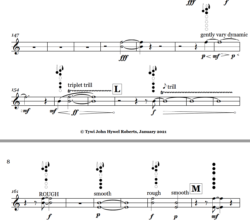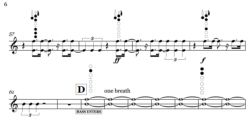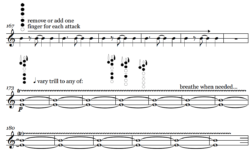RNCM: Tywi Robert 'Slushball Earth'
[originally written in Feb/March 2021, but a scheduling error meant the post is only going up now]
Garden of Forking Paths collaborations – Tywi John Hywel Roberts & Johanna Leung, Planetary Boundaries – Human Needs, and Slushball Earth
This is a two-part post, with composer Tywi's reflections first, the the clarinettist Johanna after the break below.
Tywi's post:
 Johanna and myself have been collaborating remotely on this project since Spring 2020. The arrival of COVID precluded us from meeting in a room at any point, but through sharing files and regular Zoom meetings, we were able to generate a great deal of sonic material and ideas to eventually incorporate into the score which became the clarinet part for Slushball Earth.
Johanna and myself have been collaborating remotely on this project since Spring 2020. The arrival of COVID precluded us from meeting in a room at any point, but through sharing files and regular Zoom meetings, we were able to generate a great deal of sonic material and ideas to eventually incorporate into the score which became the clarinet part for Slushball Earth.
From the beginning, our approach was experimental, if not exactly scientific. My first suggestion to Johanna went like this:
To begin with, I was thinking perhaps if you simply selected 2-4 multiphonics which you like (either easiest to play, or ones you like the sound of the most), and record yourself playing them in multiple different ways?
So for example:
- as softly as possible, as loudly as possible, and some from the range in between
- as long as possible, as short as possible, and some from the range in between
- reproducing the multiphonic in quick succession, as fast as possible
- with maximum air sound
- with minimum air sound
- beginning the multiphonic, then randomly altering your finger positions (adding/removing keys, sliding finger tips partially over holes gradually)
Soon after, Johanna sent me recordings of herself working with a variety of her favourite multiphonics, applying or questioning the above suggestions throughout. We were both particularly drawn to some of the fingerings that brought out the potential for a ‘roughness’ of timbre.
As a composer with an electroacoustic background, I was immediately compelled to play with these sounds and explore their sonic and rhythmic possibilities. This certainly did not preclude having fun and applying techniques such as sound collage, time-stretching, gating, pitch shifting, and various other manipulations.
Around the same time: I was engaged in a project with RNCM’s Practice and Research in Science and Music institution (PRiSM), which focussed on the theme of climate change (Changing Music in a Changing Climate), mentored by Laura Bowler and Sarah Nicolls. The theme of indeterminacy, as well as the sensitivity of the clarinet to temperature and other factors when attempting to produce multiphonics, seemed in my mind to have an affinity with this topic. Small factors can end up having an outsize influence in a climatic system after all. As such: I began creating pieces using Johanna’s recordings in parallel with the voices of climate scientists talking about their field. I was particularly interested to see if anything musically useful could be teased out of multiphonics by tying them to speech, and having the latter drive the composition.
My first full length piece for this project was Planetary Boundaries – Human Needs, which was premiered in PRiSM’s Changing Music in a Changing Climate concert on Thursday 15th October 2020. It was an entirely fixed media piece, with no ‘live’ component, but made extensive use of the multiphonics Johanna had recorded. In the future once physical concerts are possible again, I hope to arrange a version of this piece for live instruments.
Throughout this time I continued sharing the sounds I created with Johanna, and we began going through a process of dissecting the results together in a series of regular meetings. These were less creative and exploratory, and much more focussed on our figuring out basic aspects of which fingerings had been used where in the soundscapes, which notes they contained, how to notate these clearly, and what is possible for the player in terms of reproducing these sounds. The requirement of clearly indicating which register(s) the clarinettist should focus on came out of these little two-person workshops.
The next stage was to feed our findings back into my writing, making use of the information and knowledge we had obtained. In Autumn 2020, I began working on Slushball Earth. This piece is a follow-up to Planetary Boundaries that makes use of the voice of Katherine Turner —a PhD ocean and climate scientist from the University of Liverpool. She had recorded herself answering five short questions supplied by myself. The plan with this series is to pose the same questions to a number of different climate scientists, and thus find another path to indeterminacy through their disparate answers.
Early in the process of writing this piece, I made the ‘Gate’ effect a key part of the production and composition. All the other forces would be (mostly) dependent on the recording of Katherine’s voice, and would only become audible when the volume of her speech reached a certain level in the recording. When applied to the clarinet multiphonics: I became very interested in how the resulting ‘jerky’ rhythms could impact the sound produced by the instrument, if the player attempted to repeat the same multiphonic a number of times in quick succession.
The rapid rhythms produced by the gate function in the computer did not seem to be feasible for a human player – we determined that leaving less than a crotchet at 96bpm would not leave sufficient time for the onset of the note to create the split frequencies required. Nevertheless: building segments of the piece around quick rhythmic succession (while keeping the tempo in an acceptable range) provided another route to unpredictability in the resulting sound – rearticulating the notes was likely to introduce irregularities between each one, which would vary every time the piece was played.
I began constructing the score for the live clarinettist for Slushball Earth once the ‘studio’ track had been completed in its entirety. To guide the construction of the scored part I created a mock-up in the DAW using Johanna’s previous recordings – finding space where they could mutually complement the existing material. I then went through the process of scoring what I heard in this mock-up – attempting to match the rhythm and find ways to vary the register, or more importantly: leave room for Johanna to make choices in this area.
The first section of the score makes use of spectral multiphonics, as documented by Heather Roche. In these instances, the fundamental pitch is fingered and the clarinettist needs to overblow to draw out the other notated pitches in the altissimo and clarino ranges. Given that the clarinettist would be able to see these pitches clearly notated, I here gave them the choice of which note/register to focus on – provided they change this focus on each attack. Johanna took this and decided to allow her ear to follow the recording, and seek out commonalities in the notated harmonics on which to focus. She also noted the tendency to draw out harmonics first when overblowing in these cases, which ended up providing some opportunities to transition the sound from harmonic to multiphonic, adding further to the options for indeterminacy in the sound.

Fig-1: smooth and rough (audio)
Something similar was offered by the later points in the score which specifically call for a ‘smooth’ or ‘rough’ execution of each multiphonic. Transitioning between the two timbres is also called for, though Johanna noted how challenging this can be to achieve. Being more interested in the different results which the instruction could yield depending on the player, I was inclined to see this as another welcome opportunity for differences in interpretation between players of this piece.
The middle section of the piece reduces the score to three lines, representing the three registers of the clarinet. Personally I found this a very freeing method of composing for multiphonics, since it essentially removed a great deal of extraneous information. A variety of fingerings are deployed here – all of which were explored by Johanna and myself in our earlier sessions, and which often play in a basic way with loading the instrument through the addition or removal of single fingers ‘upstream’ from the rooted lower fingers. The use of the simplified 3-line stave made it a great deal easier to explore the frequencies offered by each fingering, and even shift between them with greater clarity, and clearly indicate the intended rhythms.

Fig-2: three-line stave (audio)

Fig-3: indeterminate fingering variation. (audio)
My intention was to make sure the score was playable, while also being a worthy challenge for Johanna’s skills. From the reports she has made to me since: it seems that the latter was certainly true, even if we are less sure about the former…
Johanna's post:
 This document is an evaluation on the whole experience working on Slushball Earth by written by Tywi John Hywel Robert, as part of the Garden of Forking Paths project. I will draw upon my experience of idea development, learning the score, recording, reflecting on my end product and any other possible possibilities from the collaborating performer’s point of view.
This document is an evaluation on the whole experience working on Slushball Earth by written by Tywi John Hywel Robert, as part of the Garden of Forking Paths project. I will draw upon my experience of idea development, learning the score, recording, reflecting on my end product and any other possible possibilities from the collaborating performer’s point of view.
Idea development
This project starts with exchanging sample materials based on multiphonics that I found easy to play. As a ‘classical trained’ musician, I find it difficult to replicate the exact sound every single time as I am very used to adjust the embouchure and air speed to get the ‘normal note’. I find it helpful to document which register to focus and referring back to the recorded material in order to determine the specific sound that I am aiming for. From performance practice, it is very effective to start with less technical multiphonics and always have a reference point (the easy multiphonic) throughout the experimental process.
Experimenting sessions
During the experimenting sessions, I take away or add different fingers based on the fundamental fingering. I found that the ‘rough’/ balanced multiphonics are easier to experiment around as they produce a smooth transition. However, this is only limited to the multiphonics that share the notes in same focusing register. I tend to keep the same embouchure and air speed while experimenting. This is helpful to produce a smooth transfer between the multiphonics as well as ‘making sense’ in changing between note. As the naturae of multiphonics is unstable, I took a few practice sessions to get the expected sound.
After that, we moved on to work on multiphonics with metronome. The experimental materials were written by Tywi, marked crochet equals 96 with different rhythmic devices. I found it difficult to play up to speed due to the unstable nature of multiphonics and the insufficient understanding of impedance of each multiphonics. I found it most comfortable and manageable for crochet equals 80. Overall, I managed to replicate each multiphonics although sometimes I can only play the expected sound after playing out the note once or twice and adjust or experiment the focus register based on the multiphonics I played.
From a performer point of view, one has to understand, practice and adapt the set up of multiphonics in order to achieve precision in replicating them. I particularly appreciate the degree of freedom of interpretation that Tywi has included in the composition in an experimental, yet realistic way.
Initial audio recording
Throughout the initial recording session of the Slushball Earth (audio version), I spent hours to aim for playing exactly how the score was notated. As a result, I recorded the track in fragments in order to produce an accurate demo of the final score. The score was notated in conventional 5 stave for harmonics (as I interpreted it wrongly but later brought in this interesting idea of experimenting harmonics before putting it to a balanced multiphonics) and 3 line stave for multiphonics, which indicate the register to focus on. I found that the 3 stave score is easier to replicate the exact sound, or similar sound depending on the number of harmonics in the same register. It is very effective to interpret with freedom within a frame while interacting with the recorded electronic as part of an ‘indication’. To me, the performance notes illustrated the requirements clearly except where I should play in one breath in letter Q. In the audio recording, I sneaked in a breath as I interpreted it as long sustained note while Tywi was expecting a slowly decaying note. This was clarified before the final video recording.
Final video recording
The final recording is a one take video recording with the recorded electronics. This piece goes from overblown harmonics from the beginning to multiphonics in letter C. I found it challenging to adapt the embouchure as playing harmonics requires a very specific embouchure for each register while multiphonics requires very relaxed embouchure. Therefore in my interpretation, I adapt the different embouchure and focus point in letter B. This section becomes a transition with a mix of harmonics and multiphonics until I get the ‘perfect’ multiphonics in letter C.
I found it difficult to listen to the altissimo register in the live multiphonics from my instrument due to the noise cancellation in the earphone. With the instability and occasional counting mistakes, it is extra helpful when I have cue from the score and bar number indication in the garage band metronome on an electronic piece without distinctive structure. When this situation occurs, I tend to listen to the general rhythm of the electronics until the next clear rehearsal figure/ letters comes back.
This piece requires one to be familiarized with the recorded track and to be musical in order to ‘play along with the mistakes’.
Further improvements
For future improvement, it would be helpful to include subdivided structure such as A1, A2…, visual cues such as visual metronome or even a video scrolling score with click track. I look forward to any further development on Slushball Earth.
